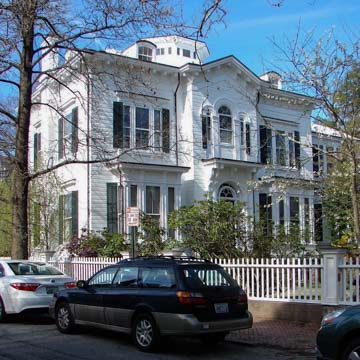Henry A. Dike, a shoe manufacturer, occupied this house only briefly. For Providence, it is an early example of the Italianate villa, as indicated by the way in which it incorporates the simple, abstract forms and large scale of Greek Revival elements into a new vocabulary of arches, heavy balconies and brackets—all shapes more attuned to primitivistic stonecutting than to wood. The shapes make sharp-edged layers down to the rusticated, flushboarded wall. Individual parts are also aggrandized into larger shapes: the square bays and deep-set door of the first story joined to the window triplets above by intervening balconies; the arching over the second-story windows merged into a strange scalloped shape; the cornice lifted into a center pediment with no distinction between the two. Whoever designed this elevation did so with sophistication, but also with a residual awkwardness not due to lack of capacity, but perhaps to a venture into new territory. Such occurred in Warren's late work, when he moved from his long familiarity with Greek Revival to embrace the new vogue for Italianate forms. Portions of the Olmsted landscaping remain, done for Albert Harkness, Brown classics professor and father of the identically named Providence architect. It subsequently became the residence of
You are here
Henry A. Dike House
1850–1852, Russell Warren(?); subsequent enlargement and renovations; 1889–1891, landscape renovation, office of Frederick Law Olmsted. 101 Prospect St. (corner of Lloyd Ave.)
If SAH Archipedia has been useful to you, please consider supporting it.
SAH Archipedia tells the story of the United States through its buildings, landscapes, and cities. This freely available resource empowers the public with authoritative knowledge that deepens their understanding and appreciation of the built environment. But the Society of Architectural Historians, which created SAH Archipedia with University of Virginia Press, needs your support to maintain the high-caliber research, writing, photography, cartography, editing, design, and programming that make SAH Archipedia a trusted online resource available to all who value the history of place, heritage tourism, and learning.














